Bulletin – June 2015 Global Economy Developments in Thermal Coal Markets
- Download the article 308KB
Abstract
Thermal coal prices increased markedly over the decade to 2011, driven by a substantial increase in global demand. That led to significant investments in thermal coal mine and port capacity, particularly in Australia and Indonesia. The resulting increases in the seaborne supply of thermal coal have underpinned a significant fall in global thermal coal prices. However, an easing of the pace of growth of global demand for thermal coal, reflecting a move towards cleaner energy sources and a slowing in the growth of aggregate electricity demand, has also weighed on prices. The outlook for prices and production over the next few years depends on a number of factors, particularly the response of Chinese demand to policy measures.
Introduction
There was a sharp increase in global demand for thermal coal over the past 15 years, driven by China's rapid economic development.[1] This underpinned a marked rise in global thermal coal prices over the 2000s, with the benchmark Japanese Fiscal Year (JFY) contract price of thermal coal peaking in 2011 (Graph 1). The increases in prices over that period led to significant expansions in investment and the global supply of thermal coal increased, including from Australia.
As supply has continued to increase and growth in demand for thermal coal has been subdued, prices have declined noticeably; spot prices have fallen by around 50 per cent since 2011. In response to these lower prices, there have been a number of closures of higher-cost mines around the world (including some smaller Australian operations) and delays to planned investment, while coal producers have focused their efforts on reducing costs.
This article provides an overview of the global market for thermal coal. It also discusses the factors that have underpinned the fall in prices over the past few years and their effect on Australian coal producers.
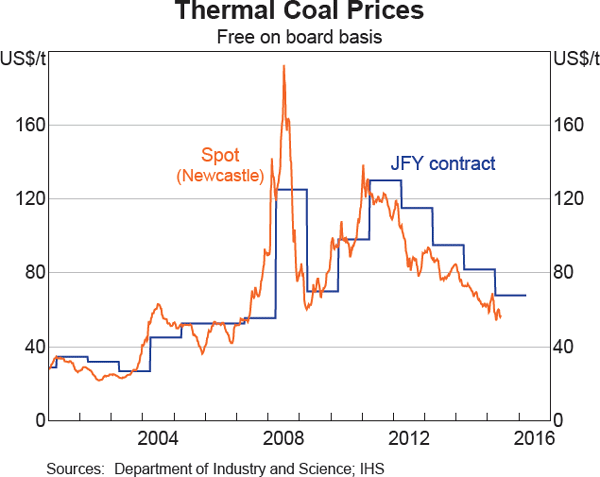
Thermal Coal Markets
Production of thermal coal is dominated by China, North America and India, which together accounted for over 70 per cent of global production in 2013 (Graph 2). The vast majority of coal produced in these countries is consumed domestically, due to the high cost of transporting coal (relative to production costs).
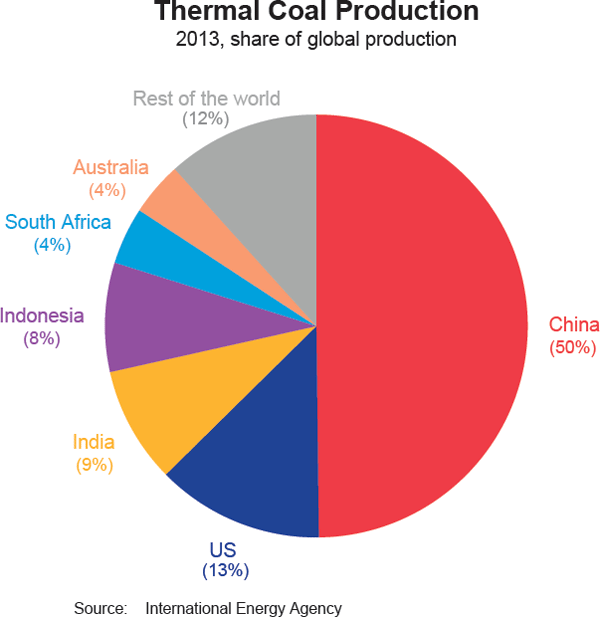
Nonetheless, seaborne trade of thermal coal is also important for many economies. China and the euro area are the largest importers of thermal coal, while Indonesia and Australia are the largest exporters (Graph 3). The importance of Australian and Indonesian exports for global thermal coal trade is due to the small size of their domestic energy requirements relative to production, as well as their proximity to key sources of demand.
Due to high transportation costs, global trade in thermal coal has historically been segmented between two regional markets: the Atlantic market and the Pacific market. The Atlantic market involves exports from the Americas to Europe, and the Pacific market largely involves Australian and Indonesian exports to the rest of Asia. These two markets are linked by Russia and South Africa, which, due to their geographical location, tend to supply both markets depending on price differentials. However, certain market dynamics – which depend on low freight costs, relative price differentials and fluctuations in supply – can result in trade between the two geographical markets overlapping (RBA 2013).
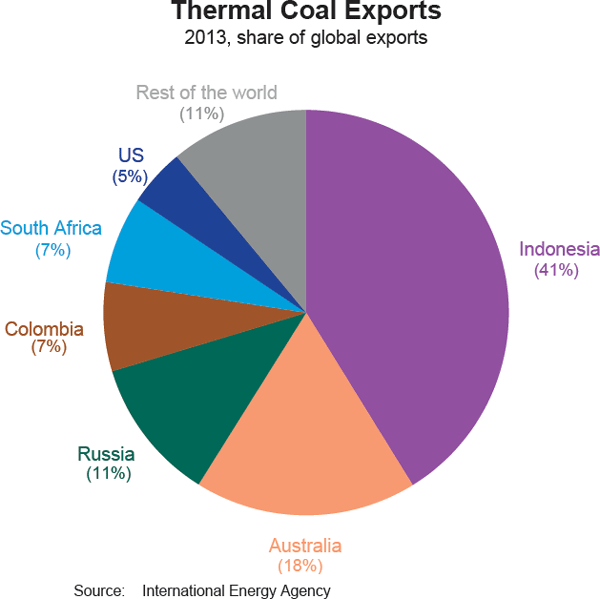
Differences in quality also affect thermal coal trade, as power generation plants often have technical constraints on the types of coal they can use. For example, Japanese power plants tend to value higher quality coal and price stability. Conversely, Chinese buyers have more tolerance for lower quality coal and can switch between higher- and lower-grade coal depending on the price. As a result, Japan is the largest destination for Australian thermal coal exports (which tend to be of a higher quality than Indonesian exports), while China is the largest destination for Indonesian coal exports.
The pricing arrangements for thermal coal vary between different source and destination countries. Annual contracts are the usual pricing arrangement with Japanese importers. The JFY contract price between Australian producers and Japanese power utilities is also used as a benchmark for other contract prices in the Pacific market, particularly for exports to Korea. For exports to other destinations, including China, transactions tend to occur on spot markets. The Newcastle thermal coal spot price is the benchmark price for most Australian thermal coal sold on shorter-term contracts (RBA 2013).
Trends in global demand
Coal is used to generate around 40 per cent of the world's electricity, and this share has remained relatively stable over the past 15 years (Graph 4). Coal's importance for global electricity generation reflects several factors, including its reliability as a base-load energy source and its relatively low cost.[2] Coal's share of electricity generation is particularly high in China, Australia and India, reflecting the substantial domestic reserves in these countries.
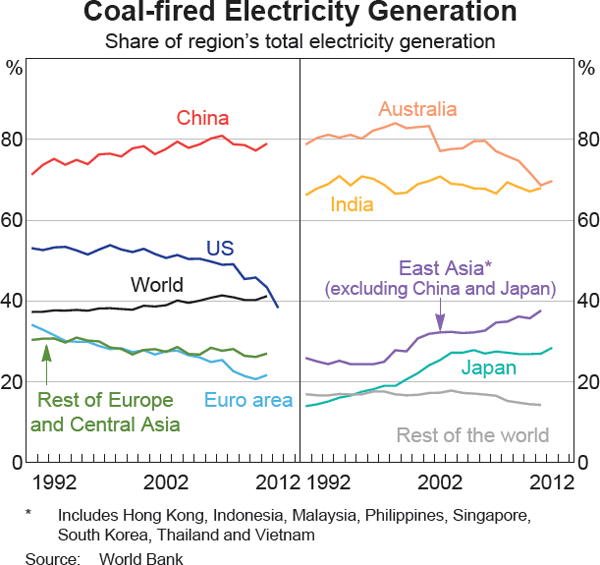
China's rapid economic development over the 2000s drove a sharp increase in global demand for thermal coal. China surpassed the United States as the largest generator of coal-fired electricity in 2006 and accounted for 41 per cent of global coal-fired electricity generation in 2011 (up from 18 per cent in 2000; Graph 5). Demand for thermal coal in the rest of Asia also increased noticeably over the 1990s and 2000s. In India and east Asia (excluding China and Japan), this increase in demand was largely due to relatively strong economic growth and urbanisation. In Japan, demand for thermal coal increased until the mid 2000s, owing to significant investment in coal-fired power plants to replace the country's high-cost oil generators.
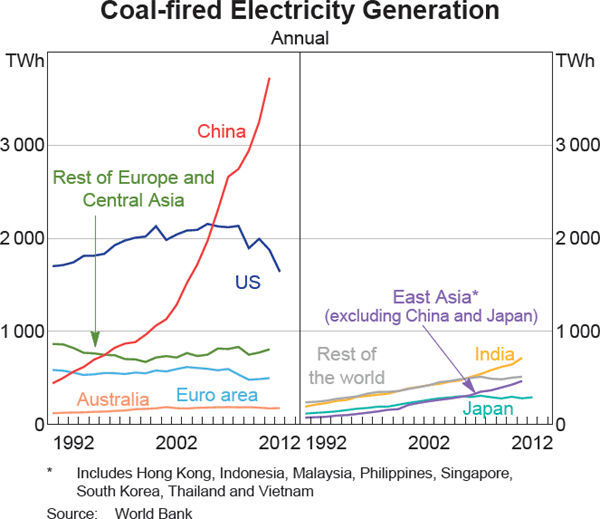
In contrast, coal-fired power generation fell in the United States and euro area over the 2000s, reflecting a move towards cleaner energy sources and an increase in the competitiveness of gas-fired electricity generation. In the United States, there was a particularly marked shift in demand towards gas from late 2011. This shift towards gas-fired power generation coincided with the sharp fall in domestic gas prices and the increase in production of unconventional gas from shale rock.
Trends in global trade
The sharp rise in Chinese demand for thermal coal saw global trade in coal increase significantly from the mid 2000s (Graph 6). Historically, China has been self-sufficient in thermal coal, owing to the country's substantial domestic reserves and production capacity. However, China became a net importer of thermal coal in 2009 and surpassed the euro area as the world's largest importer in 2011. The sharp increase in Chinese imports of thermal coal reflected both the rapid increase in demand and the lower cost of imports relative to domestic production. The price competitiveness of coal imports is largely a result of geographical factors. A large share of China's coal deposits is located in the north and west of the country, so coal must be transported to the north-east coast and then shipped by sea to southern locations. Coal imports have also been supported by the closure of smaller mines in China due to safety concerns.
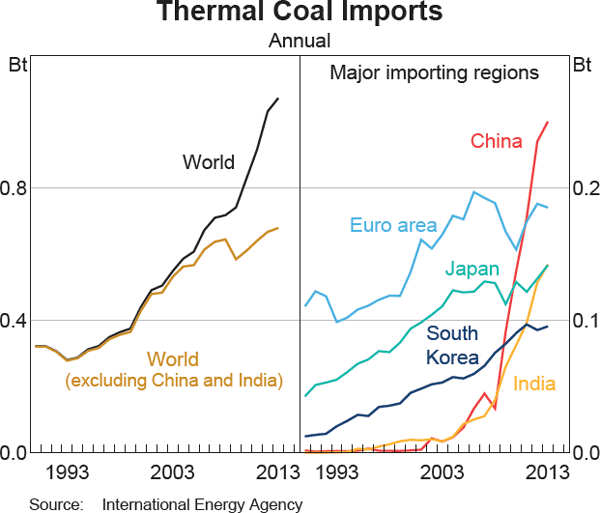
There was also a sharp increase in Indian imports of thermal coal from the mid 2000s. Despite its significant coal reserves, a lack of investment in coal mines and infrastructure has seen India become increasingly reliant on imports to meet their domestic energy requirements. Imports accounted for around 22 per cent of India's consumption of thermal coal in 2013, up from just 3 per cent in the early 2000s.
This strength in Chinese and Indian demand underpinned a sharp rise in seaborne thermal coal prices. The supply of thermal coal from the two largest exporters, Australia and Indonesia, increased markedly in response to these higher prices (Graph 7). The rapid expansion in Australian and Indonesian coal exports was facilitated by high investment in resource extraction and infrastructure. Similarly, Russian exports of thermal coal increased noticeably from the early 2000s, although growth was somewhat constrained from the late 2000s due to rail bottlenecks in Russian Far East.
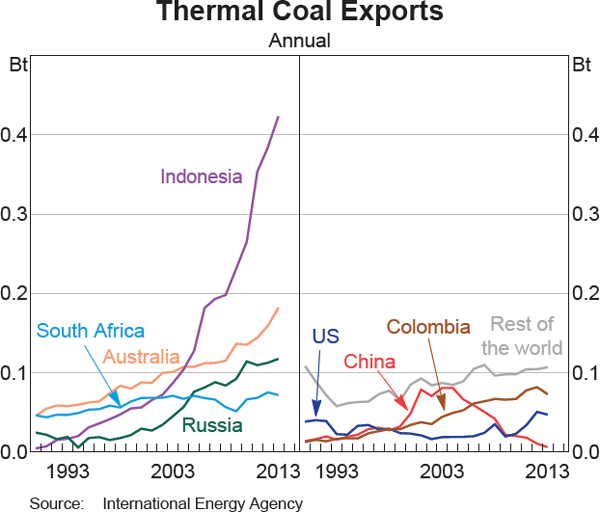
Recent Developments
As mentioned above, the contract and spot prices of thermal coal have declined markedly over recent years, reflecting both subdued growth of global demand and significant increases in supply. In response to lower prices, many companies have focused on reducing production costs, while some companies have closed mines.
Subdued demand
Demand for thermal coal across a number of major electricity producing regions has been relatively weak since 2011 (Graph 8). This weakness partly reflects a slowing of growth of aggregate electricity generation, particularly in China, and is consistent with a moderation in the growth of activity in China's energy-intensive manufacturing sectors (Graph 9). There also appears to have been a substitution away from coal and towards cleaner energy sources.
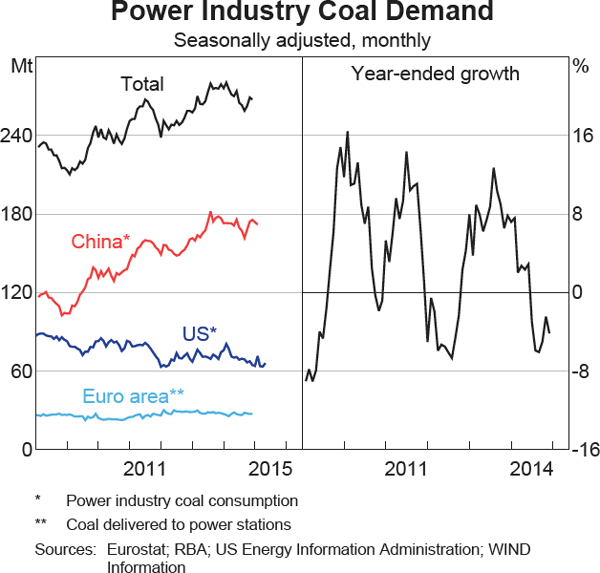
In China, the shift in demand towards cleaner energy sources has been motivated by a number of policy measures to combat air pollution.[3] While coal remains the dominant source of power generation in China, these actions have contributed to an increase in the share of electricity generation provided by non-coal sources (Graph 10).
Coal-fired electricity generation in the United States has also been relatively weak in recent years, owing largely to the increased cost competitiveness of gas-fired electricity generation (Graph 11). This shift towards gas-fired electricity generation has been aided by the retirement of many ageing coal-fired generators. In 2012, 10 gigawatts (GW) of coal-fired capacity was retired, representing around 3 per cent of the country's total capacity in 2011 (EIA 2014).
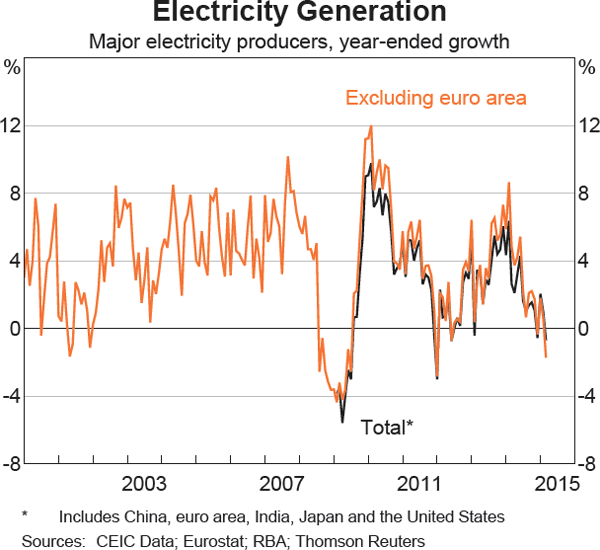
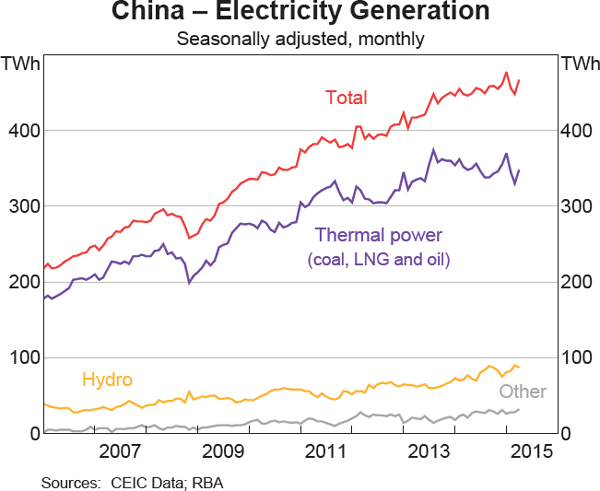
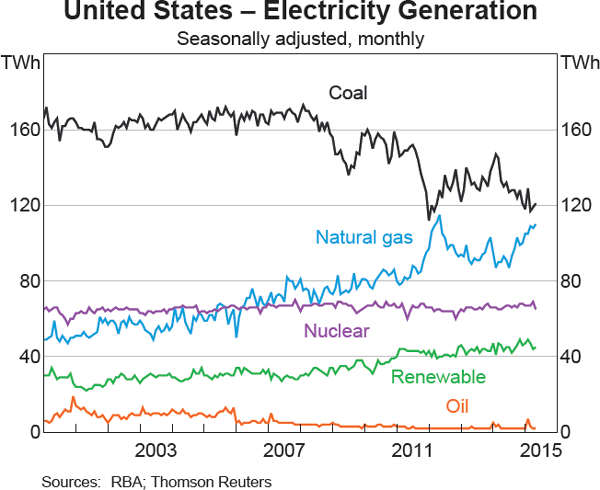
The US Energy Information Administration expects a further 13 GW of coal-fired capacity to be retired in 2015 due to the introduction of stricter emissions standards earlier this year (EIA 2015).
In contrast, coal demand from power plants in the euro area increased strongly in 2011 and 2012, despite aggregate demand for electricity remaining relatively flat. This increase in demand for thermal coal was likely to have been a response to the decline in coal prices over this period, as well as high regional gas prices. However, this strength in demand was short-lived and coal deliveries to power plants fell in late 2013 and early 2014 as a result of a decline in aggregate electricity production, increased output from renewable energy sources and the retirement of many coal plants.
Demand for thermal coal from India and east Asia (excluding China and Japan) appears to have continued to rise in recent years. Japanese demand for thermal coal has also remained at a relatively high level, supported by the shutdown of the nation's nuclear reactors in the wake of the March 2011 Tohoku earthquake (Graph 12). However, growth in demand for coal has been somewhat constrained by a lack of spare coal-fired capacity, given that many generators were already operating at close to capacity prior to the earthquake. As a result, much of the decline in nuclear power generation has been met by increased output from gas-fired power generators.
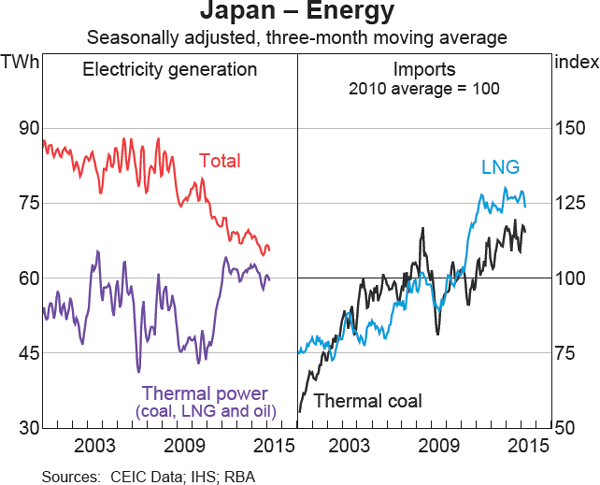
Increases in seaborne supply
Significant investment in new mines and capacity expansions has resulted in growth of thermal coal supply outpacing demand over the past few years. The completion of these investment projects has also seen producers increasingly focus on productivity improvements. These factors have contributed to significant declines in thermal coal prices since 2011. A sharp fall in oil prices since mid 2014 is also likely to have put downward pressure on thermal coal prices, insofar as it has reduced coal extraction and transport costs and enabled supply to be maintained.
A comparison of cost curves over time illustrates how the dynamics of the global seaborne market have changed (Graph 13).[4] The significant increases in supply from lower-cost producers have resulted in the thermal coal cost curves shifting outward in recent years. The cost curves have also flattened, due to both the expansions to low-cost supply and a fall in production costs at existing mines.
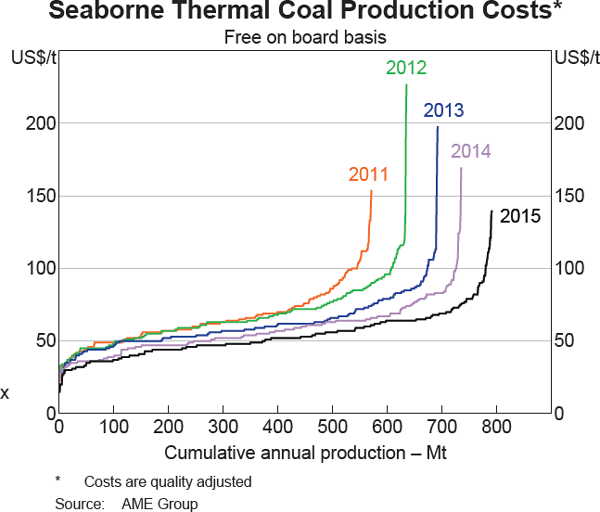
The increases in seaborne supply have been driven by Australia and Indonesia. Australian thermal coal exports have continued to increase in recent years, due to the completion of capacity expansions and the ramp-up of production from newly completed mines (Graph 14). Indonesian exports of thermal coal and brown coal have also remained at a high level. However, Indonesian exports have eased slightly since 2012, owing to both weaker Chinese demand and domestic policy changes in Indonesia.[5]
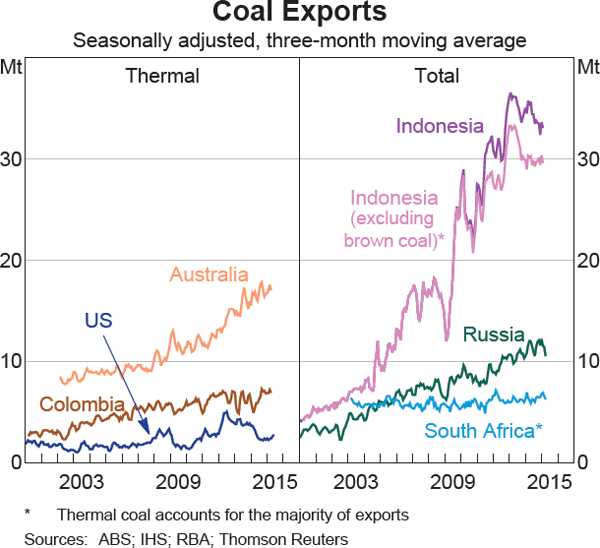
Responses to lower prices
In response to lower prices over recent years, some companies have opted to close higher-cost mines, while a number of projects in the investment pipeline have also been delayed. A large share of the supply response to lower prices over the past 18 months has been in the United States. While exports from Indonesia and Australia remain at or around historically high levels, a combination of lower production rates and mine closures has seen exports from the United States return to their 2011 levels (Graph 14).
The decline in thermal coal prices over recent years has also coincided with a moderation of Chinese coal production (Graph 15). While part of this weakness reflected subdued demand for coal from Chinese power plants, it is likely that the easing of Chinese coal production also represents the displacement of high-cost domestic production with low-cost imported thermal coal.
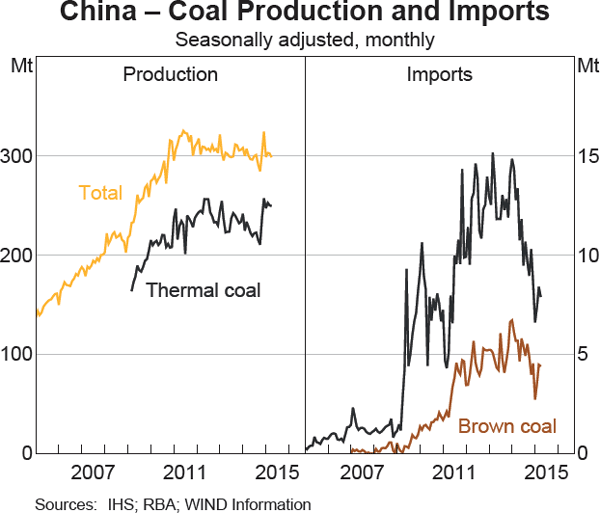
Chinese authorities have announced several policies aimed at supporting the domestic coal industry, including a directive for power utilities to reduce their usage of imported thermal coal and introducing tariffs on thermal coal imports.[6] The implementation of these policies, together with weaker Chinese demand for thermal coal, has resulted in a marked decline in Chinese thermal coal imports since early 2014. There has been a significant decline in Chinese imports from Indonesia and some smaller exporters, while imports from Australia have declined more modestly.
Chinese authorities have made several announcements over the past year encouraging coal producers to moderate production, in an attempt to support domestic coal prices.[7] However, the response of domestic production to these announcements is likely to have been offset, to some extent, by the various policies aimed at reducing the country's reliance on imported coal.
Australian Producers
Thermal coal accounted for around 5 per cent of Australia's total exports in 2014. The significant investment in Australia's coal mining and port capacity has driven a marked increase in Australian thermal coal exports over the past decade. However, investment in the coal sector has fallen sharply since 2012, with a number of projects having been cancelled or delayed over this period in response to lower prices.
At current prices, a significant share of seaborne thermal coal supply is unlikely to recoup its costs of production (Graph 16). Nonetheless, there have been very few closures of Australian mines to date and most producers have continued to focus on cutting costs and improving efficiency. The limited response of Australian supply so far is likely to reflect several factors.
First, Australian coal producers have been among the most effective at reducing production costs. These cost reductions appear to have been facilitated by the composition of costs for Australian producers. Extraction costs comprise the majority of Australian costs and are generally more responsive than land freight costs, which are a more significant cost for other major exporters. Within the extraction cost component, labour, fuel and maintenance expenses are estimated to be the largest components for most Australian producers. These appear to be the cost components that Australian coal producers have been able to reduce the most since 2011.
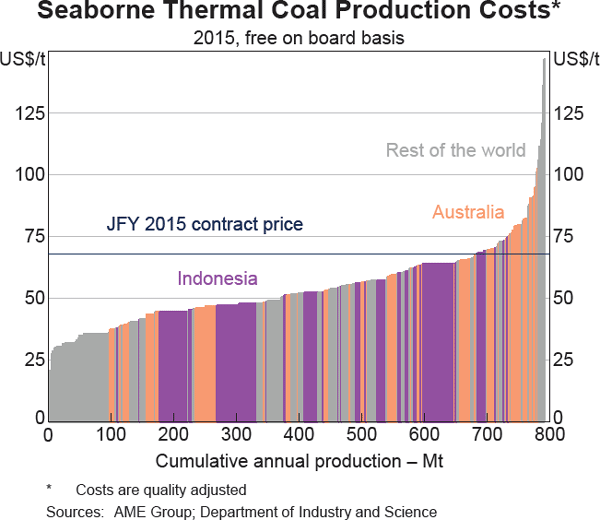
Second, the existence of take-or-pay contracts for rail transport may limit the supply response for some Australian mines, at least for a time. In a take-or-pay contract, the miner purchases a fixed amount of transport capacity and must pay for it, regardless of whether they use the capacity. These contracts are commonly used in the Australian thermal coal industry, as the fragmented supply chain can cause significant coordination issues between miners, port operators and rail companies, as well as the potential for insufficient infrastructure investment.
And finally, the depreciation of the Australian dollar has offset some of the impact of declining prices for Australian producers. This is because prices are primarily denominated in US dollars, while a large share of Australian coal production costs are in Australian dollars. Therefore, a depreciation of the exchange rate increases revenues relative to costs. However, while the depreciation has increased the competitiveness of Australian production relative to the United States and China, the exchange rates of other major coal exporters have also depreciated since 2011.
Outlook
The relatively low cost of coal-fired power generation, and its stability as a source of base-load power generation, is expected to support thermal coal demand over the medium term, particularly in China and India. However, the outlook for Chinese demand will largely depend on broader economic activity in China, particularly in the energy-intensive manufacturing sectors.
The pace of expansion in the global seaborne supply of thermal coal is expected to slow over the next few years, as existing investment projects reach completion and there are few plans to commit to new projects. Indeed, the falls in thermal coal prices over the past few years may elicit a reduction in existing supply from higher-cost producers. In Australia, the extent of any additional mine closures and the level of exports will depend on the ability of Australian producers to continue to reduce costs relative to international competitors. Nevertheless, the rate of cost reductions is likely to slow as the easiest measures are exhausted.
The outlook for prices depends on a number of factors, including the response of Chinese demand to various policy measures aimed at reducing the role of coal in its energy mix and protecting its domestic coal industry. Overall, thermal coal prices are expected to remain at relatively low levels over the next couple of years, owing to the high level of thermal coal supply and a continued shift towards cleaner energy sources in some countries.
Footnotes
The author is from Economic Analysis Department. This work has benefited greatly from previous internal analysis on the thermal coal market. The author would particularly like to thank Tim Atkin, Corrinne Dobson, Stephen Elias and Tenzin Ringpapontsang for their contributions to this analysis. [*]
Most coal falls into three broad categories – coking coal, thermal coal and brown coal. Coking coal is typically used for steelmaking and attracts a price premium over other coals. Thermal coal (also known as steaming coal) is generally used for power generation. Brown coal is also used for power generation, although its use is less common than thermal coal as it has much lower energy content and produces high levels of carbon emissions. [1]
Base-load generators produce electricity at a fairly constant rate and generally only shut down occasionally for maintenance or repairs. These plants have low production costs but require large upfront capital investments. It also takes a long time to change the level of production from these plants, so they are not suited to meeting rapid changes in demand. [2]
As part of the 12th Five Year Plan (2011–2015), the Chinese Government announced plans to reduce energy use per unit of GDP by 16 per cent from its 2010 level by 2015, and reduce coal's share of energy consumption from 68 per cent to 65 per cent. More recently, the State Council's Energy Development Strategy Action Plan (2014–2020) outlined plans to cap annual primary energy consumption and reduce coal's share of energy consumption to 62 per cent (Westpac-Department of Industry and Science 2015). In September 2014, the National Development and Reform Committee (NDRC) also announced bans on the transport, import, production and use of coal that does not meet certain ash and sulphur content requirements from 2015. [3]
The cost curves are based on the average variable costs of production of different mines and are constructed by ranking production at each mine according to its costs (RBA 2014). [4]
In October 2014, the Indonesian Government introduced regulations requiring the implementation of more rigorous checks of coal exporters' paperwork at Indonesian ports, in an attempt to reduce the amount of unlawful production. Indonesia's exports of coal are also likely to have been affected by the Domestic Market Obligation, which requires that a proportion of output of coal is reserved for the domestic market. [5]
In mid 2014, the NDRC directed power utilities to reduce coal imports by around 50 million tonnes (Mt) in 2014. In October 2014, authorities also introduced a 6 per cent tariff on thermal coal imports in order to support the domestic coal industry. Under the recently signed China-Australia Free Trade Agreement, the tariff on Australian thermal coal will be phased out over two years. [6]
In August 2014, the China National Coal Association (CNCA) urged coal producers to reduce their 2014 production targets by 10 per cent. The CNCA also announced plans in April 2015 to reduce domestic coal production by 5 per cent in 2015. [7]
References
EIA (US Energy Information Administration) (2014), ‘How is the Fuel Mix for US Electricity Generation Changing?’, Energy in Brief, 14 October.
EIA (2015), ‘Scheduled 2015 Capacity Additions Mostly Wind and Natural Gas; Retirements Mostly Coal’, Today in Energy, 10 March.
RBA (Reserve Bank of Australia) (2013), ‘Box A: Thermal Coal Prices’, Statement on Monetary Policy, February, pp 13–15 .
RBA (2014), ‘Box B: Iron Ore and Coal Cost Curves’, Statement on Monetary Policy, August, pp 18–19.
Westpac-Department of Industry and Science (2015), ‘Developments in China's Energy Policy’, China Resources Quarterly, February, pp 22–23.
Copyright and Disclaimer Notice
IHS Global Pte Ltd (IHS) disclaims any and all liability associated with any proprietary IHS information used in this article. IHS advises readers to use their own judgement and due diligence to verify any such IHS information.